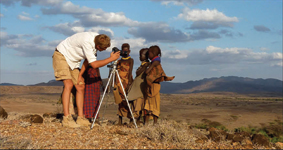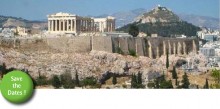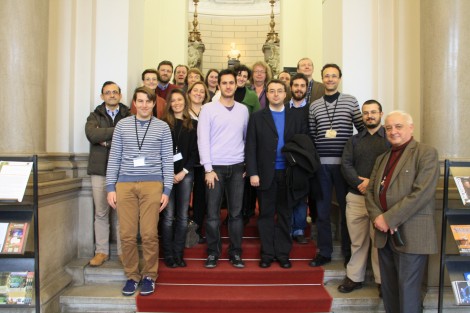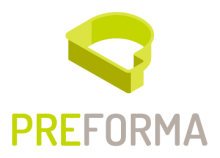-
Join the
Digital Meets Culture
Newsletter! -
Join the
Digital Meets Culture
Open Newsroom! If you have interesting news and events to point out in the field of digital cultural heritage, we are waiting for your contribution.
If you have interesting news and events to point out in the field of digital cultural heritage, we are waiting for your contribution.
-
Free text
-
-
Upcoming events
 The Summer School will be held in Zlarin, Croatia, on September 20-24, 2024. The deadline for submissions to the Public Call is June 24, 2024.
The Summer School will be held in Zlarin, Croatia, on September 20-24, 2024. The deadline for submissions to the Public Call is June 24, 2024.-
 Following, an article from the project's team, providing a report of the meeting
Following, an article from the project's team, providing a report of the meeting“Programme of Small-scale partnership in school education of the Erasmus+ Project From İntangible Expression to Digital Cultural Heritage European number: 2021-Round 2-KA210-SCH-0A1738D9 Our last meeting in Turkiye took part from 23rd to 27th of October in 2023 with the participation … Continue reading →
 AMRO 2024 was held in Linz from May 8 to 10, 2024
AMRO 2024 was held in Linz from May 8 to 10, 2024The 2024 edition of Art Meets Radical Openness (AMRO), the biennial festival for art, hacktivism, and open cultures, has just come to an end. Held in Linz from May 8 to 10, it offered a context for discussing the … Continue reading →
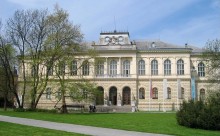
On the 18th February 2014, in the beautiful premises of the National Museum of Slovenia, it was held the third plenary meeting of EAGLE project, which included a special training session for the content providers.
The meeting, which was joined with the EAGLE Public Workshop “Current Practices and New Directions in Digital Epigraphy“, was opened by Marjeta Šašel Kos from the Scientific Research Centre of the Slovenian Academy of Sciences and Arts, Institute of Archaeology, who talked about the beginnings of Roman epigraphy in Slovenia (download the slides and the introductory text).
The morning session was dedicated to check the status of the project and to plan the next steps. Silvia Orlandi, Claudio Prandoni, Pietro Liuzzo, Valentina Vassallo updated all the partners about the progress of each Work Package highlighting the most important issues and action items to be taken into consideration in the coming months.
In the afternoon a more practical workshop followed to present to the content providers the aggregation infrastructure, the services that are available to upload and check the content and the ingestion plan to provide to Europeana the first set of metadata. The workshop, which was organised by CNR-ISTI (Andrea Mannocci, Giuseppe Amato) and The Cyprus Institute (Valentina Vassallo) included also a demonstration of the image recognition algorithm which will be intergated in the EAGLE Mobile Application to help users to get more information about an inscription by sending a photo of the epigraph.
Below, some photos taken at the plenary meeting in Ljubljana by Andrej Šemrov and Matija Pavlovec.
Next appointment for the EAGLE project will be on the 29-30 September and 1 October 2014 in Paris, with the First EAGLE International Conference on Information Technologies for Epigraphy and Digital Cultural Heritage in the Ancient World.
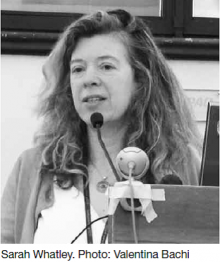
This article, first published in the Winter 2014 edition of Animated magazine, is reproduced by permission of Foundation for Community Dance. All Rights Reserved. See www.communitydance.org.uk/animated for more information.
Professor of Dance and Director of the Centre for Dance Research (C-DaRE) at Coventry University (RICHES’ Partner) Sarah Whatley argues for a change in perceptions for every body dancing.
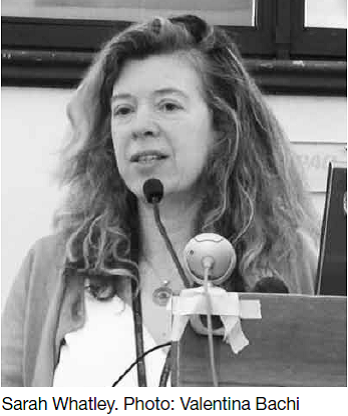 Perhaps the greatest barrier for dancers with disabilities accessing dance at a Higher Educational (HE) level is the perception that a career in dance is ‘off limits’ to them. A student may feel that the course will not prepare them with the skills, knowledge and independence to take them into work beyond graduation. But every aspiring dance student is different. Each has their own sense of ability and identity, and sometimes multiple identities (which may include them as a member of the disabled community). But it is probably the case that whilst the student with a disability has had to come to terms with a sense of being more different her entire life, and the realities of the barriers that get in the way of her being able to ignore her difference, the prejudices that still lurk in the dance studio and are re-inscribed in the ‘perfected’ dancing bodies in the name of ‘excellence’ and ‘quality’ persist through an aesthetic of similarity and flawlessness. And that does no favour to any dancer, disabled or non-disabled, and neither does it move the artform forwards.
Perhaps the greatest barrier for dancers with disabilities accessing dance at a Higher Educational (HE) level is the perception that a career in dance is ‘off limits’ to them. A student may feel that the course will not prepare them with the skills, knowledge and independence to take them into work beyond graduation. But every aspiring dance student is different. Each has their own sense of ability and identity, and sometimes multiple identities (which may include them as a member of the disabled community). But it is probably the case that whilst the student with a disability has had to come to terms with a sense of being more different her entire life, and the realities of the barriers that get in the way of her being able to ignore her difference, the prejudices that still lurk in the dance studio and are re-inscribed in the ‘perfected’ dancing bodies in the name of ‘excellence’ and ‘quality’ persist through an aesthetic of similarity and flawlessness. And that does no favour to any dancer, disabled or non-disabled, and neither does it move the artform forwards.
There are of course examples of individuals with disabilities, who have carved out interesting and productive careers as dancers and in the dance sector more generally, but these individuals are too few and many have had to find a way into the profession that has bypassed full-time HE or vocational dance training. So whose responsibility is it to ensure that dancers with disabilities are included?
Many dance curricula do not overtly discriminate against the dancer with disabilities. But that doesn’t mean to say that the curriculum is accessible, appropriate and inviting to those students who may perceive themselves to be discriminated against. Some are more explicit in addressing inclusion; for example the relationship between Trinity Laban and Candoco, now just over a year in operation, has, according to the website, been set up ‘to achieve greater access for disabled people into the dance profession and to advocate for the importance of inclusive practice in enhancing creative endeavour’. Such statements are to be welcomed but where (else) is change happening? Most dance courses place unusually high demands on students when compared to other subject domains. Students work long hours, working collaboratively with others, developing a wide range of intelligences, all of which can feel daunting to navigate for students with physical, sensory or cognitive disabilities. Students are unlikely to find themselves in classes where there are others with visible disabilities, so whilst there may be an ethos of inclusion within the class, the experience of the student who feels her difference to be hypervisible may be that she finds the dance class (in particular) an uncongenial environment in which to feel equal but different.
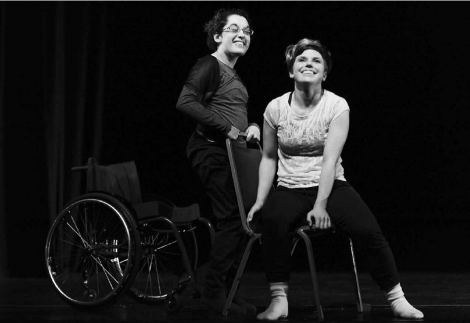
Anna Bergstrom and Kimberley Harvey, Subtle Kraft Co., Cravings of Intimacy & Solitude, Theatre Clywdd, Wales. Photo: Roswitha Chesher
The uncomfortable truth is that there is also still anxiety and fear amongst many who design and teach courses in dance in HE about how to accommodate and support students with disabilities. This is not surprising given the additional work needed. No student, disabled or not, simply slips into an existing provision without some kind of adaptation or additional support, if only for monitoring how the various strands of a course and its related assessment take account of, or not, the individual’s needs.
So what will make a difference? We have to change perceptions and this begins much earlier than the time when students might access HE. We also have to invite disabled students to audition and apply for our courses and then learn with them about how we might need to shift or rethink our curricula. Hopefully each student will be a valuable ambassador to encourage others to follow but this carries with it a weight of responsibility, which not all students will want.
Equally if not more important, we have to appoint role models in our institutions; as dance course leaders, studio teachers, managers, lecturers and researchers. Then the discourse of ‘inclusion’ will evolve to reflect an inclusive community of practice in our universities and colleges, and beyond into the profession, which focuses on the materiality of every dancing body and which will then, in turn, undermine those structures that still persist in reinforcing systems of oppression and exclusion in dance.
For more information: http://www.communitydance.org.uk/animated-magazine.html
Read the full article, with the contributions of Benjamin Dunks (benjamin@attik.org.uk), Artistic Director of Plymouth’s Attik Dance, and Kimberley Harvey (kimberleyharvey1@aol.com, www.subtlekraftco.tumblr.com), freelance dancer, teacher and choreographer – PDF
contact s.whatley@coventry.ac.uk
visit www.c-dare.co.uk
www.invisibledifference.org.uk

 IRCDL – the Italian Research Conference on Digital Libraries – is a yearly deadline for Italian researchers on Digital Libraries related topics.
IRCDL – the Italian Research Conference on Digital Libraries – is a yearly deadline for Italian researchers on Digital Libraries related topics.
The CULTURA Environment: the IPSA Collection is the paper by Maristella Agosti, Nicola Ferro, Nicola Orio and Chiara Ponchia who has been submitted to the 10th edition – IRCDL 2014 – to present and disseminate the final results of the CULTURA project.
One of the focus of IRCDL 2014, hosted by the Department of Information Engineering of the University of Padua, was on emphasizing the multidisciplinary nature of the research on digital libraries which not only goes from computer science to humanities but also crosses among areas in the same field ranging, for example, from archival to librarian sciences or from information management systems to new knowledge environments.
This is a continued challenge for the DL field and there is the need to continue to contribute to improve the cooperation between the many communities that share common objectives.

 The final results of the CULTURA project have been presented and disseminated at the 2nd AIUCD Annual Conference 2013 on Collaborative Research Practices and Shared Infrastructures for Humanities Computing, hosted by the Department of Information Engineering of the University of Padua.
The final results of the CULTURA project have been presented and disseminated at the 2nd AIUCD Annual Conference 2013 on Collaborative Research Practices and Shared Infrastructures for Humanities Computing, hosted by the Department of Information Engineering of the University of Padua.
The AIUCD (Associazione Italiana per l’Informatica Umanistica e la Cultura Digitale) focused for its annual conference on interdisciplinary work and new developments in the field of the digital humanities.
Jan Christoph Meister, keynote speaker from the University of Hamburg in Germany, presented the work of Narratology’s most famous fore runner, the Russian folklorist Vladimir Propp’s, highlighting its affinity to a digital humanities approach.
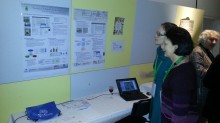
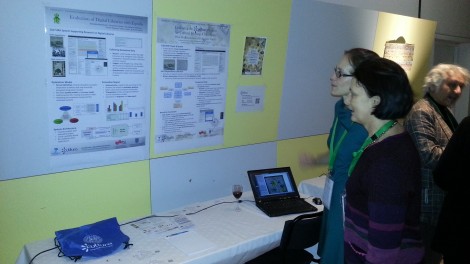 Two CULTURA posters have been presented at the NODEM Conference in Stockholm on 3 December 2013.
Two CULTURA posters have been presented at the NODEM Conference in Stockholm on 3 December 2013.
The first poster “Evaluating the CULTURA System for Cultural Heritage Collections: What do Researchers of Tomorrow Think?” reported on an evaluation study conducted with Irish history students.
The second poster “Integrating and Testing the Evaluation Service Equalia for Digital Libraries and Beyond” presented the Evaluation Service Equalia and how it is integrated with the CULTURA System.
Numerous discussions with conference participants raised awareness of the CULTURA project and its approach and solutions.
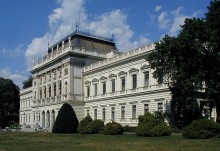
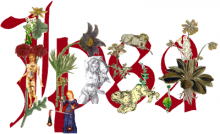 On 21st January 2014, in cooperation with the Austrian Centre for Digital Humanities at the University of Graz the TUG team had the opportunity to give a presentation on the CULTURA project to humanities students in the lecture ‘Basic Module: Digital Humanities’.
On 21st January 2014, in cooperation with the Austrian Centre for Digital Humanities at the University of Graz the TUG team had the opportunity to give a presentation on the CULTURA project to humanities students in the lecture ‘Basic Module: Digital Humanities’.

The CULTURA project and system were introduced as an initiative and showcase for information modelling and technology in the humanities.
The final version of the CULTURA system was demonstrated with the 1641 Depositions and the IPSA collection.
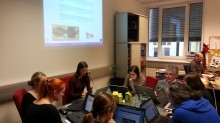
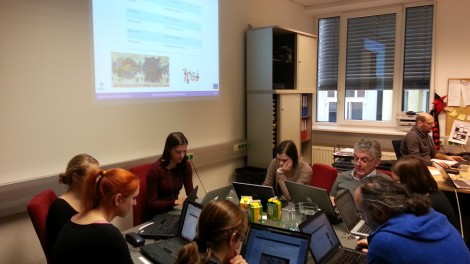 On 10th January 2014 a half-day workshop was conducted at the Austrian Centre for Digital Humanities (ZIM) at the University of Graz.
On 10th January 2014 a half-day workshop was conducted at the Austrian Centre for Digital Humanities (ZIM) at the University of Graz.
Workshop participants were members of the centre, as well as researchers from the Dialect Cultures project.
The final version of the CULTURA research environment was demonstrated with the 1641 Depositions and the IPSA collection.
In a hands-on session participants had the opportunity to try out the system with both collections.
The workshops was very useful for gathering meaningful user feedback on CULTURA, but also in terms of disseminating the project results to experienced members of the digital humanities community.

Memory institutions are facing increasing transfers of electronic documents and other media content for long term preservation. Data are normally stored in specific file formats for documents, images, sound, video etc. that are produced by software from different vendors. This software is controlled neither by the institution that produces the files, nor by the institution that holds the archive. As a result, memory institutions have to make conformance tests before accepting transfers of electronic collections, but these tests are again out of control and not totally reliable. This poses problems in long-term preservation. Data objects meant for preservation, passing through an uncontrolled generative process, can jeopardise the whole preservation exercise.
The main objective of PERFORMA (PREservation FORMAts for culture information/e-archives) – a Pre Commercial Procurement project co-funded by the European Commission under its FP7-ICT Programme – is to give memory institutions full control of the process of the conformity tests of files to be ingested into archives, through the development of a set of tools which enable this process to happen within an iteration that is under full control of the institutions.
Aim of this workshop is to present to the whole digital preservation community – open source community, developers, standardization bodies and memory institutions – the new opportunities offered by the project and by the forthcoming call for tender.
Description
The main objective of the pre-commercial-procurement launched by PREFORMA is the development and deployment an open source software licensed reference implementation for file format standards aimed for any memory institution (or other organisation with a preservation task) wishing to check conformance with a specific standard. This reference implementation will consist of a set of modular tools, which will be validated against specific implementations of specifications of standards relevant to the PREFORMA project and used by the European memory institutions for preserving their different kind of data objects. In order to demonstrate effectiveness (and refine) these tools, they will be developed in an iterative process with multiple releases and with a number of experiments with ‘real’ data sets (files) from memory institutions during each iteration.
Media types covered by the tender are: documents, images, audio-visual records.
Areas which will be covered by the tools developed by PREFORMA are:
- Preservation-relevant metadata (for documents, books, images and audio-visual records).
- Particularly challenging types of digital objects (notably audio-visual records).
- Integration of digital preservation requirements in existing systems in order to increase their resilience against technological changes.
The total costs of the procurement amounts to 2,805,000 euro.
Six suppliers are planned to be selected at the end of the tender procedure to carry on the first design phase that lasts 4 months and completes with the ranking of the delivered designs.
The suppliers of the best three designs are requested to proceed to the prototyping phase, which includes two releases and the re-design phase and which lasts 22 months in total. These suppliers are then requested to proceed to the testing phase that lasts 6 months and which corresponds to the final testing with real data sets provided by the memory institutions.
Target communities and stakeholders
PREFORMA aims to ensure the establishment of a process of Open Dialogue, which involves:
- Memory institutions and cultural heritage organisations coordinating or representing them, that are involved in (or planning) digital culture initiatives.
- Developers contributing code for the PREFORMA tools as well as developers implementing the reference implementations in production software.
- Research organisations providing technical and expertise advice to cultural stakeholders.
- Standardisation bodies maintaining the technical specifications of the preservation formats covered in PREFORMA.
- Funding agencies, such as Ministries of Culture and national/regional administrations, that own and manage digitisation programmes and may endorse the use of the PREFORMA tools in the digitisation process.
- Best practice networks endorsing the use of open standards in creating and managing digital content.
- Other projects in the digital culture, e-Infrastructures and policy arenas.
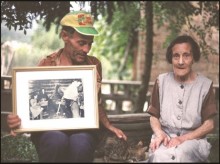
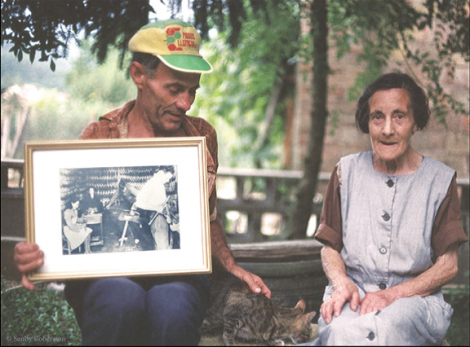 The Royal Anthropological Institute organized a major international conference ‘Anthropology and Photography’, which took place at the British Museum’s Education Clore Centre on 29-31 May 2014.
The Royal Anthropological Institute organized a major international conference ‘Anthropology and Photography’, which took place at the British Museum’s Education Clore Centre on 29-31 May 2014.
The Royal Anthropological Institute of Great Britain and Ireland (RAI) is the world’s longest-established scholarly association dedicated to the furtherance of anthropology (the study of humankind) in its broadest and most inclusive sense. The Institute is a non-profit-making registered charity and is entirely independent. Aim of its “Anthropology and Photography” Conference is to stimulate an international discussion on the place, role and future of photography in anthropology and related disciplines. Participation of researchers and practitioners working in museums, academia, media, the arts and anyone who is engaged with historical or contemporary production and use of images is welcomed. The conference attracted thousands of delegates from around the world, including archaeologists, anthropologists, photographers, curators, social scientists, representatives of corporate bodies, media professionals, NGOs, teachers, students and the general public. Europeana Photography was invited by RAI and participated in the conference presenting its recent outcomes and future activities.
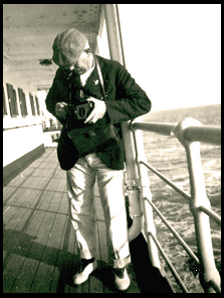
For more information please visit:
http://www.therai.org.uk/conferences/anthropology-and-photography/
Download the conference flyer – PDF
